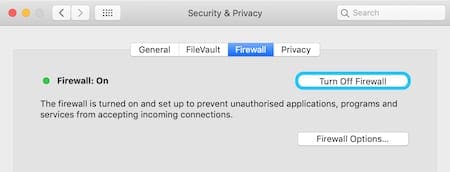
Catalina’s built-in software firewall acts as the wall surrounding your MacBook castle by allowing in the communications you want while preventing unknown communications from potential threats. The Catalina firewall works with your Internet connection and with any networks you may have joined.
How to Configure Your Mac's Firewall; Meet Your Macinstructor. Matt Cone, the author of Master Your Mac, has been a Mac user for over 20 years. A former ghost writer for some of Apple's most notable instructors, Cone founded Macinstruct in 1999, a site with OS X tutorials that boasts hundreds of thousands of unique visitors per month. The firewall on your Mac may block real incoming connections thus resulting in access errors. Whenever you install third party apps, Mac will prompt you to confirm the security access. If you have blocked access without understanding then the app will be added in the blocklist of your firewall.
To display the Firewall settings, click the System Preferences icon on the Dock and then click the Security & Privacy icon. Click the Firewall tab to display the settings you see below.
If your Mac’s firewall hasn’t yet been turned on, click the Turn On Firewall button to start the ball rolling. (In the above image, this button has toggled to Turn Off Firewall because your Mac’s firewall is already on.)

Is the Turn On Firewall button disabled? Don’t panic; just click the padlock icon in the lower-left corner. If Catalina prompts you for your Admin user account password, type it and then click Unlock.
Click the Firewall Options button, and Catalina presents four options you can set:
- Block All Incoming Connections: It’s not usually a good idea to use this option because turning it on reduces the data you receive, cutting off access to the Internet for virtually all your applications. (In other words, blocking all incoming Internet connections is overly drastic security that prevents you from doing many nifty things with your MacBook. If all your third-party applications suddenly can’t connect to the Internet and Safari still works fine, check this setting to see if it was enabled by mistake.) Use this feature only if you suspect that your Mac is the target of an Internet hacking attack.
- Automatically Allow Downloaded Signed Software to Receive Incoming Connections: Enable this one right now. After you do, software you’ve installed that’s accompanied by a valid security certificate (including any application from Apple and most major third-party software developers) is automatically added to the Allowed list you see on the Firewall Options sheet. If an application without a security certificate tries to access the Internet, your Mac displays a dialog prompting you for confirmation, and you can decide yes or no.
- You can manually add an application to the Allowed list. Click the button with the plus sign at the bottom of the list and then navigate to the application that needs to communicate with the outside world. Click the application to select it and then click Add. Remember: Only third-party applications you install yourself will likely need to be added to the Allowed list, because all the applications that Apple includes with your Mac are already on the list.
- To delete an application from the Allowed list and return it to blocked status, select it in the list and click the button with the minus sign.
- You can edit the settings in a specific application by clicking the pop-up menu on the right side of the entry. By default, the setting is Allow Incoming Connections (including both your local network and the Internet). However, you can choose Block Incoming Connections to prevent that application from receiving any communications.
- Enable Stealth Mode: Here’s an option that you should turn on. Stealth mode helps prevent hackers from attacking your Mac by preventing it from responding to simple identification queries across the Internet. Hackers often search the Internet for available computers that automatically respond to such queries.
Free Firewall Os
If you suddenly can’t connect to other computers or share files that you originally could share, review the settings that you enabled on this pane: They may be the culprits.
You can also verify that the correct sharing services are still enabled in the Sharing pane within System Preferences. (When you enable a service through the Sharing pane, Catalina automatically adds that service to the Allowed list.
Mac Os Firewall Open Port
When you turn on Printer Sharing on the Sharing pane, for example, Catalina adds a Printer Sharing entry to the firewall’s Allowed list.) Open the System Preferences window and click the Sharing icon, and make sure that the services you want to provide are selected.